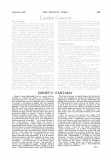
Disney' s latest full-length film is a series of illustrations to well known pieces of orchestral, or orchestrated, music. As such, it will attract the attention of musicians, and its audiences may be expected to include a scattering of people who are specially interested in seeing how Disney and real music get on together. They are recommended to dismiss the idea that the artist has come to meet them on their own ground. To a certain extent he has done so: say, in three of his eight episodes (though others will put the proportion higher or louver). Bach's Toccata in D minor is the first of the three Disney's scheme of moving, almost dancing, patterns may pass muster, for pattern-weaving in one art is not inapposite to pattern weaving in another. The second section is the 'Casse Noisette' Suite minus the Overture. It is accompanied by a ballet of flora and fauna so supercharged with Disney's own fancy and technique that the music is scarcely present in its own character. That fancy is, however, so exquisite that the episode is probably the most successful of all, viewed as sheer Disney. Then comes the one outstanding success of the series: the story of 'L'apprenti sorcier' with Mickey himself as the apprentice. It is as if Dukas's little masterpiece had been waiting all these years for Disney to complete it (Other works await his treatment: 'Till Eulenspiegel' is an obvious mark, or will be when the way is clear. But the field is limited. One hesitates to suggest 'Falstaff,' unless it were made a condition that Disney called in a producer.) The forth section draws upon Sravinsky's 'The Rite of Spring,' to which Disney has attached a daring and imaginative picture of primitive earth, beginning somewhere in the nebular hypothesis and ending with dynosaurs. Here we witness an unlooked-for achievement in music criticism on Disney’s part. A work that has had to fight for its place on the ballet stage and concert platform suddenly becomes an unquestionable masterpiece in the picture theatre. The music fits the picture to admiration, and Stravinsky comes out as the ideal auxiliary to a screen cartoonist.
After an interval the second part begins with Beethoven's 'Pastoral' Symphony. This is Disney's outstanding failure. Beethoven’s music is too strong in its own character and local habitation to be taken to Olympus and peopled with centaurs, centaurettes (however dainty} and cupids; moreover this episode exhibits some of the worst drawing ever seen in a Disney picture. Next we are given Ponchielli's 'Dance of the Hours' as a ballet of ostriches and hippos. Had this been the first item of its kind ever witnessed it would have caused a sensation; but to people experienced in Silly Symphonies it will appear second-rate. Moussorgsky's 'A Night on the Bare Mountain' becomes a typically overdrawn essay in the macabre. Attached to it as epilogue is an intolerable orchestral and choral version of Schubert's 'Ave Maria,' during which one onlooker, long an ardent Disneyan, sought the door. The whole film takes a little over two hours.